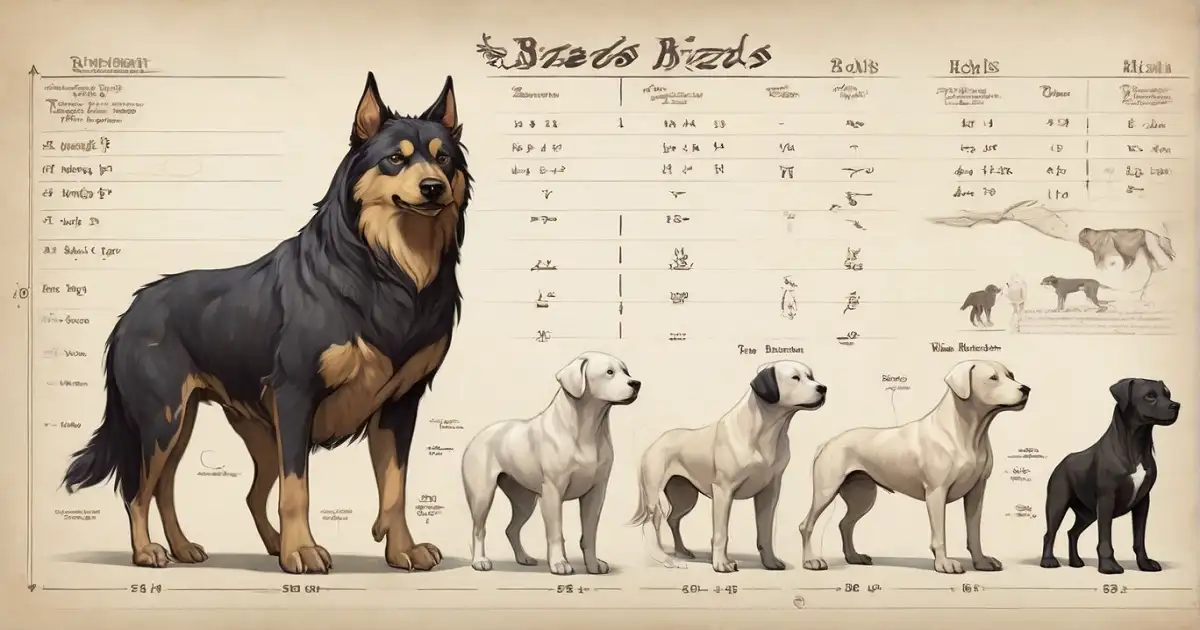Choosing the right dog breed is no walk in the park, especially when labrador and rottweiler sizes differ so much! With labradors on the medium side and rottweilers on the large, which canine fits your family best?
This pooch puzzle had my head spinning, but learning the nitty-gritty details on Labrador vs rottweiler size helped tremendously.
I’m here to lend a helping paw and walk you through the key size comparisons between these two popular breeds.
You’ll gain a solid understanding of their backgrounds, needs, and traits tied to their sizes. Let’s dig in so you can pick the perfect-sized pup for your pack!
Background on Labrador vs Rottweiler Size
The Labrador is one of America’s most beloved dog breeds and has been the most popular breed in the United States for years. Labradors originate from Newfoundland in Canada, where they were bred as retrieves for fishermen, helping haul nets and fetch ropes. Their history as water dogs makes them energetic, playful, and eager to please.
Labradors were bred as medium-sized dogs, standing 21.5-24.5 inches tall at the shoulder for males and 21-23.5 inches for females. On average, male Labradors weigh 65-80 pounds while females are 55-70 pounds. However, Labs can range a bit outside those averages depending on lineage and nutrition.
Some key facts about Labrador size:
- Male Labrador height: 22-24.5 inches
- Male Labrador weight: 65-80 pounds
- Female Labrador height: 21-23.5 inches
- Female Labrador weight: 55-70 pounds
Being medium-sized dogs originally bred for hunting and retrieving, Labradors have moderate energy levels and exercise needs. They thrive in active families and enjoy activities like walking, hiking, swimming, playing fetch, and participating in canine sports like agility.
However, Labs are adaptable and do not require constant, intense activity. Their medium size makes them well-suited to homes of different sizes, including apartments or small houses with yards. Labradors between 2-5 years old require 30-60 minutes of exercise per day on average.
With appropriate opportunities for activity and playtime, the medium-sized Lab can thrive as a happy, affectionate, family-friendly companion. Their versatile size helps make them one of America’s most popular breeds for first-time and experienced dog owners alike.
Background on Rottweiler Size
Like the Labrador, the Rottweiler originated as a working dog bred for a specific job. Rottweilers were bred in Germany as cattle dogs, driving livestock to the market and protecting the farmer’s money purse tied around their necks.
As working farm dogs, Rottweilers were bred to be much larger than Labrador Retrievers. Rottweilers typically stand 22-27 inches tall at the shoulder for males and 22-25 inches for females.
Average weights are:
- Male Rottweilers: 95-135 pounds
- Female Rottweilers: 80-100 pounds
Some key facts about Rottweiler size:
- Male Rottweiler height: 24-27 inches
- Male Rottweiler weight: 95-135 pounds
- Female Rottweiler height: 22-25 inches
- Female Rottweiler weight: 80-100 pounds
As you can see, the Rottweiler is significantly larger than the Labrador in terms of both height and weight. Male Rottweilers may be up to 50 pounds heavier than male Labs. Female Rottweilers are larger than male Labs, outweighing them by up to 30-60 pounds typically.
The Rottweiler’s much larger size was important for its traditional jobs driving cattle and defending livestock from predators or thieves. Their size and strength inspire fear in intruders.
However, the flip side is that this giant working breed requires more intensive exercise to stay happy and healthy. Rottweilers need 60-90 minutes of vigorous activity per day, such as running, hiking, or interactive play and training.
Direct Comparison of Average Size Differences
Now that we’ve reviewed some background details on the origins and average sizes of the Labrador Retriever and Rottweiler breeds let’s directly compare their size differences. Understanding the size disparity between these two popular breeds is crucial for deciding which is better suited to your family’s needs.
On average, Rottweilers are significantly larger than Labradors in terms of both weight and height:
- Male Rottweilers are 20-50 pounds heavier on average than male Labradors
- Female Rottweilers are 30-60 pounds heavier on average than female Labradors
- Rottweilers stand 2-3 inches taller on average than Labradors of the same sex
That’s a notable size difference! When visualized, the size gap becomes even more apparent:
- The average male Labrador stands 22-24.5 inches tall at the shoulder and weighs 65-80 pounds
- The average male Rottweiler stands 24-27 inches tall at the shoulder and weighs 95-135 pounds
So male Rottweilers are both taller by 2-3 inches and heavier by 20-50 pounds than male Labs. That’s a lot more dog!
Now let’s compare females:
- The average female Labrador stands 21-23.5 inches tall at the shoulder and weighs 55-70 pounds
- The average female Rottweiler stands 22-25 inches tall at the shoulder and weighs 80-100 pounds
Again, we see the female Rottweiler is larger in both height and weight, exceeding the female Lab in size.
Clearly, when considering Labrador vs rottweiler size, the Rottweiler is the larger, more substantial breed on average. The size difference between these two breeds is significant and should factor into your decision-making process when choosing a family dog.
Size Comparisons in Visual Form
Sometimes, it helps to visualize key size differences between breeds. Here are some illustrations to showcase the major size gaps between Labradors and Rottweilers:
This chart demonstrates the average differences in height, weight, and overall body size between these breeds. You can really see how much larger the sturdy Rottweiler is than the moderate Labrador.
For another visual depiction, here is a photo comparing an average-sized male from each breed side-by-side:
The Rottweiler is clearly bulkier and taller than the Labrador, especially evident when the breeds are right next to each other.
Keeping these size comparisons in mind will help you determine which breed aligns better with your family’s needs in terms of activity level, space requirements, and more.
Pros and Cons of Size for Family Friendliness
When bringing a new dog into your family, considering the breed’s typical size is an important factor that can impact your daily life. The notable size differences between Labradors and Rottweilers come with both advantages and disadvantages when it comes to family-friendly traits.
Here are some pros of the Labrador’s medium size:
- Labradors can easily adapt to small homes and apartments – their moderate size doesn’t require vast amounts of space.
- Labs are easy to transport in most vehicles – they can often safely ride loose or be comfortable in a crate or carrier.
–Labradors tend to have lower food and medication costs, given their smaller stature.
- The breed’s moderate energy needs make Labs well-suited to families that aren’t extremely active.
- Labs require less intense exercise compared to giant breeds, usually 30-60 minutes daily.
- Medium-sized Labs are easier for some owners to handle and control physically.
And some potential downsides:
- The Lab’s size limits their ability as guard dogs – they are too small to intimidate intruders.
- Their medium build provides less pulling power for strength activities like sledding.
- Rowdy kids or rambunctious pets may knock down labs in the home.
- Medium dogs, like Labs, have shorter life expectancies on average compared to toy breeds.
Now let’s look at some advantages of the Rottweiler’s larger size:
- Rottweilers can be effective guard and protection dogs thanks to their intimidating size.
- Their strength allows them to pull loads and participate in weight-pulling competitions and similar activities.
- Larger dogs like Rottweilers have a longer average lifespan compared to extremely small breeds.
- A sizeable home or yard is less of a necessity for these big canines since they exercise themselves.
- Rottweilers are sure to keep unwanted guests away due to their imposing bulk.
Some potential cons associated with Rottweilers include:
- Much larger space and stronger containment are required to house a Rottweiler properly.
- Higher caloric needs mean more expensive food bills for giant breeds like the Rottweiler.
- Medication dosages and other healthcare costs are greater for huge dogs.
- Large and giant breeds experience more bone/joint problems than smaller dogs.
- A bigger dog like a Rottweiler poses more risk of knocking over small children in the home.
- Rottweilers require much more exercise – at least 60-90 minutes daily.
By understanding these pros and cons related to size, you can determine if a medium-sized Lab or large Rottweiler is better for your family’s lifestyle. Be realistic about your ability to meet the needs of a bigger, more demanding dog before getting a Rottweiler. For many families, the moderate Labrador is easier to manage long-term.
Key Tips for Raising a Happy, Healthy Labrador or Rottweiler
Whether you choose an energetic Labrador or a powerful Rottweiler, proper training and care from puppyhood are essential to developing a well-behaved and loving companion. Consider this your cheat sheet for key tips on training, exercise, nutrition, and health for your family’s new furry friend.
House Training
- Start potty training immediately for best results – be vigilant and consistent
- Praise and treat for going to a proper outdoor location
- Limit access before house training is reliable
- Crates can help dogs learn to “hold it” and aid in housebreaking
Basic Obedience
- Enroll in a puppy kindergarten class for early socialization and commands
- Practice basic cues like sit, stay, come, and down daily to reinforce training
- Use reward-based methods like treats, praise, or toys to motivate them
- Be firm and consistent – dogs thrive on structure and leadership
Exercise Needs
- Labradors need 30-60 minutes of exercise per day, while adults
- Rottweilers require more vigorous exercise – at least 60-90 minutes daily
- Focus on brisk walks, playing fetch, or interactive toys to meet needs
- Physical and mental stimulation are important to prevent destructive behavior
Nutrition Tips
- Choose high-quality commercial dog food appropriate for breed size and age
- Feed measured portions twice per day rather than free-feeding
- Monitor weight and adjust food as needed to maintain ideal body condition
- Provide clean, fresh water at all times – hydration is vital
Grooming Basics
- Brush coats weekly using a slicker brush to remove dead hair
- Trim nails carefully every few weeks as needed
- Check and clean ears periodically – don’t insert deep into the ear canal
- Brush teeth regularly to prevent dental disease
Health Screenings
- Have your vet conduct wellness exams annually
- Keep up with preventative care like vaccines, heartworm medication
- Have your dog screened early for breed-specific conditions
- Provide flea/tick and dental care to avoid problems
Safety Precautions
- Properly ID dogs with collar tags and microchips in case they become lost
- Puppy-proof your home by removing hazards and securing chemicals
- Never leave dogs unsupervised with small children
- Train dogs to behave politely around guests to avoid incidents
Suppose you commit to these training and care practices from the start. In that case, your beloved Labrador or Rottweiler will mature into an outstanding canine companion your entire family can enjoy for years to come!
Choosing the Perfect-Sized Dog for Your Family
Selecting your family’s first puppy is tremendously exciting but also a big responsibility. While both Labrador Retrievers and Rottweilers make wonderful pets, their notable size difference is a key factor to consider. Your lifestyle, activity level, and home size should guide your decision between these two breeds.
Moderate Labradors are better suited to many suburban or urban homes where space is limited. Labs adapt well to apartments, condos, and smaller houses with modest yards. The Lab’s medium build also jibes with families that enjoy daily walks or playing fetch, but aren’t marathon runners.
First-time owners often find the Lab’s eager-to-please attitude, coupled with its more manageable size, makes training easier as well.
On the other hand, larger Rottweilers require room to roam and stretch their legs. They demand vigorous activity from their handlers. Rottweilers also excel at protection work and thrive when given a true “job” to do beyond just family pets.
Consider whether you can fully satisfy the Rottweiler’s higher exercise needs before choosing this breed. Their imposing size also requires dedicated training and early socialization.
No matter which breed you choose, commit to providing responsible care and training from day one. Puppies and adolescents are a ton of work, but that effort pays off with an amazing companion for life.
Be realistic about the time, energy, and expenses required for the breed you select. Offer your dog plenty of love, mental stimulation, healthy food, exercise, and veterinary care.
In return, you’ll get unwavering loyalty, silly antics that make you laugh, and countless memories to cherish. Here’s wishing you the very best on your journey to finding the perfect dog for your family! Remember to choose with your head and your heart.
When size matters, carefully weigh the pros and cons of the Labrador vs Rottweiler. Once you meet the right dog, you’ll just know in your soul that they were meant to complete your family and brighten your days. Stay positive!









